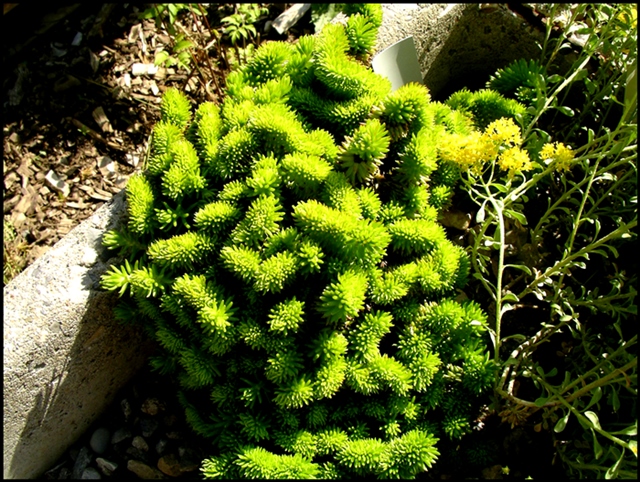Plant of the Month for April, 2014

(SEE-dum roo-PES-tree KRIS-tah-tuh)
General Information:
A well behaved, unusual sedum that always gets a comment from visitors. Sedum repustre is a common bluish green sedum that spreads quickly, and the variety S. rupestre ‘Angelina’ is a well-known yellowish version that is almost invasive. Sedum rupestre f. cristata looks quite different, and does not spread very quickly. It makes a great rock garden plant and stays small enough to be suitable for a trough.

Sedum rupestre f. cristata; photo by Robert Pavlis
The common name for this plant is Crested Stonecrop. This plant contains a genetic mutation that results in the growing point making wide stems, or crests. This growth is also referred to as a monstrata formation or fasciation. This happens in many plants and can affect stem growth or flower formation. I have seen it in delphinium stems and flowers. In most cases it is not a stable mutation, and growth the following year is normal. In the Crested Stonecrop, the mutation is fairly stable, and most new growths show fasciation. Occasionally, a normal stem will be produced and it is best to remove such growth. Give new growth a few weeks to develop the fasciation, since they tend to look normal when the side branch first starts to show. As it gets larger the crest will form.
Sedum rupestre f. cristata does not flower and is grown for its leaves. The plant can be easily reproduced vegetatively.
In winter the stems turn a nice red colour and the plant shrinks as it loses water in preparation for winter. In spring it plumps back up again. Rupestre means “rock loving” and indicates the fact that the plant likes a well-drained soil.
Life Cycle: perennial
Height: 20 cm (0.75 ft)
Bloom Time: none
Natural Range: Original species is from Central and Western Europe
Habitat: lowlands up to 2000m
Synonyms: Sedum ‘tortuosum’, Sedum reflexum, Sedum ‘Monstrosa’, Sedum ‘Cristata’
Cultivation:
Light: full sun
Soil: well drained
Water: regular moisture in spring, drought tolerant
USDA Hardiness Zone: 5 – 8
Propagation: division
Seedex availability (ORG&HPS annual Seed Exchange): never
